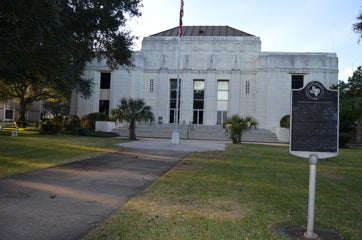World famous Clydesdales coming back to Mardi Gras
Published 6:04 pm Wednesday, December 21, 2016

- Lester, a member of the Budweiser Clydesdale team, lovingly nudges Chip the Dalmatian as Budweiser Clydesdale handler Jim Damico looks on at the Mardi Gras of Southeast Texas float barn in Port Arthur. The Clydesdales will take part in Mardi Gras parades.
“Here comes the King, here comes the big Number One!
Budweiser beer, the king is second to none.
Just say Budweiser,
You’ve said it all.
Here comes the King of Beers so lift your glass let’s hear the call.”
It’s hard not to think of the jingle when one sees the world renowned Budweiser Clydesdales. In fact, the Clydesdales will be making a return trip from Feb. 23-26 to the Mardi Gras of Southeast Texas at 601 Proctor St. in downtown Port Arthur.
The eight-horse hitch will be harnessed and hitched to the famous red beer wagon at the Port Arthur Mardi Gras grounds. The “Gentle Giants,” as they are often referred to, will participate every night in the Mardi Gras parades beginning at 5 p.m. from the 23rd – 26th.
Andy Boggan, director of special events for marketing for Del Papa Distributing Company, said the horses come to Port Arthur every three years. They started coming to Mardi Gras in the 1990s.
He added that there are three hitches that travel the nation— St. Louis, East Coast, and West Coast.
Laura Childress, president of Mardi Gras of Southeast Texas, said the Clydesdales make several engagements during the year. The event or festival must meet certain criteria such as attendance factors and tenure.
“We couldn’t schedule them without our local distributor, Del Papa, securing an agreement. We’ve had the Clydesdales several times off and on. During a Super Bowl year we don’t get them.”
Childress said the horses are a crowd favorite due to their massive size and beauty.
“They are a very nice attraction because of their majesty,” she said.
She added that there will be photo opportunities with the Clydesdales and attendees can get close enough to pet the horses on the noses.
“The Budweiser people tell us our Mardi Gras is one of their favorite events because of our hospitality and that we’re a family affair,” Childress said.
Anheuser-Busch’s Budweiser Clydesdales make hundreds of appearances each year, according to a press release. They are an American icon and one of the world’s most recognized corporate symbols.
They have been a symbol for Anheuser-Busch since 1933 and scheduled to make several appearances in the area.
To qualify for a hitch, a Clydesdale must be a gelding at least four year of age, stand 72 inches at the shoulder when fully mature, weigh between 1,800 and 2,300 pounds, have a bay coat, a blaze of white on the face, four white legs, and a black mane and tail. A gentle temperament is very important as hitch horses meet millions of people each year.
A single Clydesdale hitch horse will consume as much as 20-25 quarts of feed, 40-50 pounds of hay and 30 gallons of water per day.
Each hitch travels with a Dalmatian. In the early days of brewing, Dalmatians were bred and trained to protect the horses and guard the wagon when the driver went inside to make deliveries.
The Budweiser Clydesdales can be viewed at the Anheuser-Busch breweries in St. Louis, Mo.; Merrimack N.H.; and Ft. Collins, Colo. They also may be viewed at Grant’s Farm in St. Louis and at Warm Springs Ranch, the 300-plus acre Clydesdale breeding farm located near Boonville, Mo.
Boggan joked if he could ever come back he would want to come back as a Budweiser Clydesdale.
The Clydesdales travel in a style befitting a king. In order to provide rest for each of the eight “first-string” horses, the Clydesdale hitch teams always travel with a total of 10 “gentle giants.” The traveling caravan includes three 50-foot tractor-trailers custom-built for the horses with rubber flooring, air suspension, and vent fans to ease the rigors of hours on the road. Two tractor-trailers carry the Clydesdales and a third carries everything else including the iconic beer wagon and a full set of handcrafted, patent leather, and solid brass harness.
Performance days for a Budweiser Clydesdale are a combination of excitement and
perfection. While the horses are groomed daily, special attention is given to their appearance on performance days. The expert groomers who travel with the horses spend approximately five hours washing and grooming the horses, polishing the harness, braiding red and white ribbons into the manes, and inserting red and white bows into the tails.
Harnessing all eight horses is a process that usually takes 45 minutes. The wheel team, the horses closest to the wagon (and generally the strongest), is harnessed first proceeded by the body, swing, and lead teams. After each Clydesdale is harnessed, they are individually hitched to the red, white and gold 1903 Studebaker-built beer wagon. Finally, after all eight horses are hitched to the wagon, the driver adjusts the lines. Driving the 12 tons of wagon and horses requires strength, experience and stamina. The 40 pounds of lines the driver holds, plus the
tension, equals over 75 pounds. During long parades, the driver and the assistant often alternate driving in order to remain fresh and alert.
David Ball: 409-721-242





